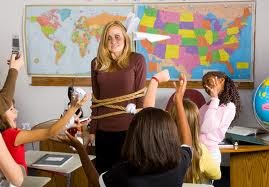The 1960's education was commonly remembered for student sit-in's, human rights, peace not war, bell bottom pants and a free, whopii, student lifestyle and control.
However the 1960's brought about a lot of innovation in teaching and learning. It embraced individuality, self paced learning and it was very student centered. We are headed to that again.
Like most educational trends, it fell away as expectations of students, popular opinion, technology, needs of industry and politics marched toward standardized testing as proof of student learning. The public schools are now entrenched in a very teacher centered educational system as teachers struggle with measuring learning that more resembles testing the probability of a student becoming a physicist.
Higher education has not been a part of that accountability until recently. Nationally the
accreditation agencies have pushed colleges to measure student learning. The State of Texas is pushing aggressively, beyond the accreditation agency standards, to measure student learning and hold colleges responsible if it is not there. They have also added employability as a measurement. According to spell check, I think they also made employability a new word.
As we progress toward UTRGV we are designing the college of tomorrow, today; right now. Our design of classrooms and teaching methods is leaning towards the successes of the 1960's open learning. Classrooms are flexible for group learning and discussion. Faculty will no longer be stuck behind a podium barrier, lording over the students. They will be facilitating learning by using electronic tools and facilities designed to have them working among the students.
Open learning in the 1960's stumbled for two reasons. One is that education has always been in search for a silver bullet. All students learn best by _________. Many solid teaching techniques were thrown out with the bathwater in search of a one-size fits all method.
Educators are smarter now. We have learned that not all students learn best by one method and not all teachers teach best by one method. Facilities need to be flexible for all styles of learning and teaching. Faculty need lots of pedagogical and technical support to produce active, experiential learning.
The second reason is that open learning was introduced like the Beatles. It was a mad, catastrophic push from England; flashy, new and exciting. Today we know to investigate new teaching ideas using formative evaluation as we discover and weigh the pros and cons and fine tune our methods. Teaching is an ongoing process as industry, politics and popular culture expectations grow and change. We will always be searching for new pedagogical ideas, adjusting for the workforce and exploring new technology.
Our lessons learned over the years is to be flexible, not only for the ways students learn but for methods faculty teach. The second is that measurements are diagnostic for improvement of teaching and students learning. Checking standardized classes off a list is not an effective passport to graduation.
Oh, and the 1960's student centered learning terminology was often misinterpreted. The term was mistakenly confused with submissive teaching toward student whims. We are smarter now. It is student interactive learning firmly guided by faculty.





Astrology forecasts AND predicts future events which can be likely to help occur based to the presumption The item astronomical phenomena IN ADDITION TO events on the human world are generally interrelated. throughout almost all cultures astronomical events are crucial. ones Indians, Chinese, AND Mayans for example created systems elaborately due to the purpose regarding predicting events here in earth Just as accurately Equally possible coming from creating certain observations coming from an celestial viewpoint. latest news
ReplyDelete